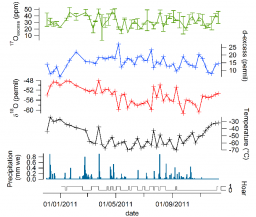Abstract: The isotopic compositions of oxygen and hydrogen in ice cores are invaluable tools for the reconstruction of past climate variations. Used alone, they give insights into the variations of the local temperature, whereas taken together they can provide information on the climatic conditions at the point of origin of the moisture. However, recent analyses of snow from shallow pits indicate that the climatic signal can become erased in very low accumulation regions, due to local processes of snow reworking. The signal-to-noise ratio decreases and the climatic signal can then only be retrieved using stacks of several snow pits. Obviously, the signal is not completely lost at this stage, otherwise it would be impossible to extract valuable climate information from ice cores as has been done, for instance, for the last glaciation. To better understand how the climatic signal is passed from the precipitation to the snow, we present here results from varied snow samples from East Antarctica. First, we look at the relationship between isotopes and temperature from a geographical point of view, using results from three traverses across Antarctica, to see how the relationship is built up through the distillation process.
We also take advantage of these measures to see how second-order parameters (d-excess and 17O-excess) are related to δ18O and how they are controlled. d-excess increases in the interior of the continent (i.e., when δ18O decreases), due to the distillation process, whereas 17O-excess decreases in remote areas, due to kinetic fractionation at low temperature. In both cases, these changes are associated with the loss of original information regarding the source. Then, we look at the same relationships in precipitation samples collected over 1 year at Dome C and Vostok, as well as in surface snow at Dome C. We note that the slope of the δ18O vs. temperature (T) relationship decreases in these samples compared to those from the traverses, and thus caution is advocated when using spatial slopes for past climate reconstruction. The second-order parameters behave in the same way in the precipitation as in the surface snow from traverses, indicating that similar processes are active and that their interpretation in terms of source climatic parameters is strongly complicated by local temperature effects in East Antarctica. Finally we check if the same relationships between δ18O and second-order parameters are also found in the snow from four snow pits. While the d-excess remains opposed to δ18O in most snow pits, the 17O-excess is no longer positively correlated to δ18O and even shows anti-correlation to δ18O at Vostok. This may be due to a stratospheric influence at this site and/or to post-deposition processes.
Reference : Climate of the Past, Vol. 12, pages 729-748, 2016







